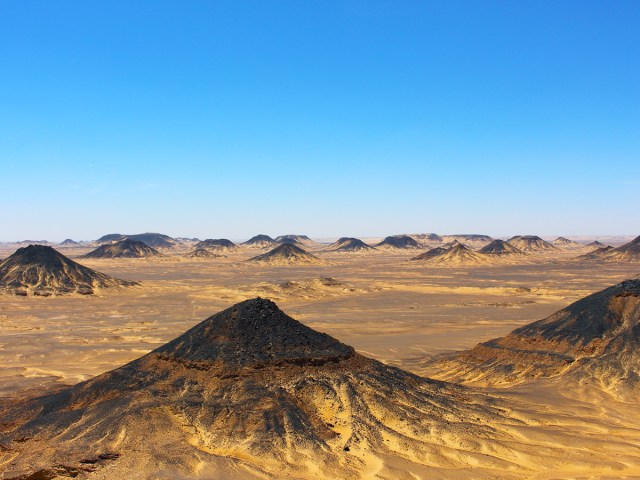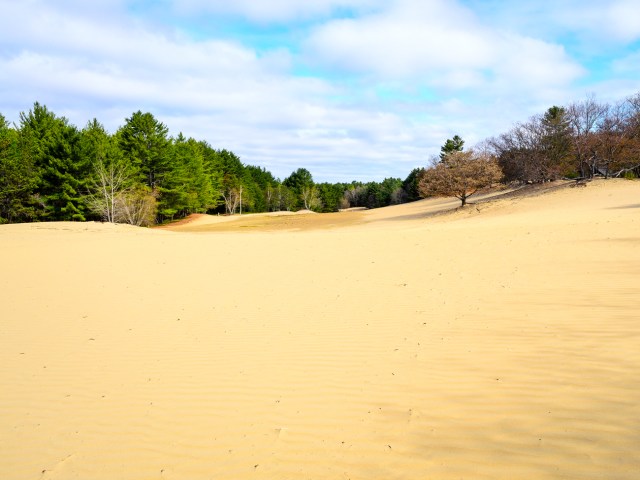Picture a desert and you’ll probably imagine an expanse of dry, cracked earth, scorching temperatures, and maybe some cacti. But not all deserts fit this mold. A desert is simply defined as an area that receives very little precipitation, and the types of deserts found across the planet can differ dramatically. Indeed, the location of the planet’s largest desert will probably surprise you. Below, check out six of the most unusual deserts on Earth.
Atacama Desert – Chile

The Atacama Desert is one of the world’s oldest deserts — and also one of the driest places on Earth. The average rainfall is just 0.6 inches per year; until the early 1970s, some parts of the desert hadn’t seen rainfall for around 400 years. Covering 40,000 square miles along the Pacific coast in northern Chile, the Atacama landscape features vivid colors of mineral-rich rock, lagoons, and salt flats. A combination of the Andes Mountains blocking any rain that could blow in from the east, and an atmospheric condition caused by super cold Pacific water inhibiting evaporation, means constantly clear skies over the desert. This also accounts for the desert’s popularity as a site for observatories — the world’s highest observatory, the University of Tokyo Atacama Observatory, is located here. The desert’s Valle de Marte (which translates to “Mars Valley”) is famous for its resemblance to the red planet — in fact, NASA even used the valley to mimic the conditions on Mars for research.
Antarctic Polar Desert – Antarctica

The criteria for what counts as a desert has nothing to do with sand or heat — generally, it’s any place that receives less than 10 inches of precipitation per year. Earth’s largest desert covers about 5.5 million square miles on the continent of Antarctica. The Antarctic Polar Desert gets less than 2 inches of precipitation each year and has an average temperature of -20 degrees Fahrenheit. It can get as cold as -90 degrees, or 30 degrees at its warmest. Because of its harsh climate — and the ice covering 90% of the continent — no one permanently lives in the Antarctic Polar Desert (or on the continent of Antarctica).
Carcross Desert – Yukon Territory, Canada

The Carcross Desert in Canada’s Yukon Territory is only about 1 square mile big, but what it lacks in size it makes up for in interest. Some call it the smallest desert in the world; others, the northernmost desert. And some experts claim that it’s not a true desert at all, because it’s too humid. Whatever the truth, it was once the bed of a Pleistocene glacial lake and stays dry thanks to the rain shadow of nearby mountains. Harsh winds restrict most plant life, but there are some incredibly rare species there — including the Yukon lupine flower and Dall sheep.
Black Desert – Egypt

Not to be confused with Nevada’s Black Rock Desert, famous for hosting the annual Burning Man Festival, the Black Desert is an arm of Egypt’s Western Desert, located about 30 miles south of the town of Bawiti. Also called the Sahara Souda, the desert features a layer of black powder spread over hundreds of conical hills. The inky material comes from volcanic activity that occurred during the Jurassic period and has eroded from nearby mountains.
The highest point in the Black Desert is the “English Mountain,” a popular spot to take in the otherworldly, charcoal-dusted views. Tours of the Black Desert are often combined with trips to the nearby White Desert, about 75 miles southwest, where tectonic activity and sandstorms have shaped the limestone into waves and bizarre formations that resemble livestock, trees, and even ice cream cones.
Desert of Maine

While Maine is better known for its lush pine forests, the state’s “most famous natural phenomenon,” according to Smithsonian Magazine, is a curious 40-acre stretch of silt and sand known as the Desert of Maine. While the sand dunes here may resemble the Gobi or Sahara smack dab in the middle of New England, the Desert of Maine doesn’t technically qualify as an actual desert — the area experiences too much precipitation. However, the odd juxtaposition of desert sand and pine trees is enough to draw around 30,000 tourists a year.
The “desert” is a result of ice age glaciers that grounded down to silt over the period of about 10,000 years. This silt was for a long time unexposed, as topsoil covered it. But due to poor land management and improper rotation of crops, soil erosion led to the discovery of the sand below, and it has since become a popular tourist attraction.
Wadi Rum – Jordan

It’s easy to see why Wadi Rum — a fantastical desert valley in southern Jordan, near the Saudi Arabia border and the Red Sea — is also known as the Valley of the Moon. The landscape of nearly vertical red sandstone gorges, natural sandstone arches, and massive caverns is thrillingly disorienting and could easily be mistaken for an alien planet. Hollywood directors have noticed, too, using the valley as an otherworldly stand-in for films such as Dune, Prometheus, The Martian, and most famously, the 1962 classic film Lawrence of Arabia — a movie that put Jordan’s tourism industry on the map.
In 2011, UNESCO declared Wadi Rum (which translates to “dry valley”) a World Heritage Site, not just for the spectacular scenery but also for the region’s human history, which dates back up to 12,000 years. There are an estimated 25,000 petroglyphs throughout the valley — gorgeous rock art that provides a fascinating glimpse into the lives of Wadi Rum’s earliest inhabitants.
More from our network
Daily Passport is part of Inbox Studio, which publishes content that uplifts, informs, and inspires.
















